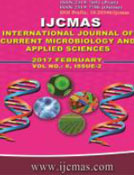


 National Academy of Agricultural Sciences (NAAS)
National Academy of Agricultural Sciences (NAAS)

|
PRINT ISSN : 2319-7692
Online ISSN : 2319-7706 Issues : 12 per year Publisher : Excellent Publishers Email : editorijcmas@gmail.com / submit@ijcmas.com Editor-in-chief: Dr.M.Prakash Index Copernicus ICV 2018: 95.39 NAAS RATING 2020: 5.38 |
Cryptococcosis is an acute, subacute or chronic fungal disease caused by an encapsulated Basidiomycetes yeast belonging to the genus Cryptococcus. Among the many species of the genus “Cryptococcus” ubiquitously present in the environment Cryptococcus neoformans and Cryptococcus gattii are clinically significant. Cryptococcal meningitis is considered as an AIDS defining condition and is the most common fungal infection of the central nervous system in patients with or without impaired immune function. Histoplasmosis is a systemic granulomatous disease caused by a dimorphic fungus, Histoplasma capsulatum. Clinical manifestations may be classified according to site (Pulmonary, extrapulmonary or disseminated), duration of infection (acute and chronic) and pattern of infection (primary Vs reactivation). Several studies have proved the association of these two pathogenic fungi with bird droppings and soil contaminated with bird droppings. Therefore the present study was undertaken over a period of one year (from 1st Nov 2014 – 31st Oct 2015) in the Department of Microbiology, Mata Gujri Memorial Medical College and Lions Seva Kendra Hospital, Kishanganj, Bihar with bird excreta samples and soil samples (fifty each) collected from Kulik Bird sanctuary, Raiganj, Uttar Dinajpur for isolation of these two fungi. After processing of the samples cultures were done on Sabouraud’s dextrose agar with Chloramphenicol and 2nd set of culture on SDA with chloramphenicol and cycloheximide. Both the culture sets were kept both at 250C as well 37ºC followed by Germ tube test, growth on corn meal agar, inositol assimilation test, nitrate assimilation test, growth on bird seed agar, growth at 370C and urease test for C. neoformans and lactophonol cotton blue mount done to search thick walled large tuberculate macro conidia of H. capsulam from white or buff brown colonies on SDA at 250C. Fifty soil samples did not show any growth of C. neoformans whereas three out of fifty bird excreta samples showed growth of C. neoformans. None of the hundred samples showed any growth of H. capsulatum. Therefore isolation of C. neoformans from bird droppings collected from the study site has provided useful informations for ecological and epidemiological studies of C. neoformans which may help to prevent public health hazards.
 |
 |
 |
 |
 |